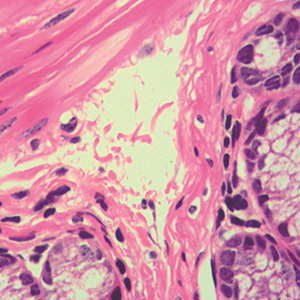Endoplasmic reticulum stress contributed to inflammatory bowel disease by activating p38 MAPK pathway

Submitted: 4 April 2022
Accepted: 16 May 2022
Published: 23 May 2022
Accepted: 16 May 2022
Abstract Views: 1116
PDF: 792
HTML: 39
HTML: 39
Publisher's note
All claims expressed in this article are solely those of the authors and do not necessarily represent those of their affiliated organizations, or those of the publisher, the editors and the reviewers. Any product that may be evaluated in this article or claim that may be made by its manufacturer is not guaranteed or endorsed by the publisher.
All claims expressed in this article are solely those of the authors and do not necessarily represent those of their affiliated organizations, or those of the publisher, the editors and the reviewers. Any product that may be evaluated in this article or claim that may be made by its manufacturer is not guaranteed or endorsed by the publisher.
Similar Articles
- D. Fanni, S. Nemolato, R. Ganga, G. Senes, C. Gerosa, P. Van Eyken, K. Geboes, G. Faa, Cytokeratin 20-positive hepatocellular carcinoma , European Journal of Histochemistry: Vol. 53 No. 4 (2009)
- CarloAlberto Redi, Apoptosis - Methods and Protocols , European Journal of Histochemistry: Vol. 54 No. 1 (2010)
- S. Huang, S. Guo, F. Guo, Q. Yang, X. Xiao, M. Murata, S. Ohnishi, S. Kawanishi, N. Ma, CD44v6 expression in human skin keratinocytes as a possible mechanism for carcinogenesis associated with chronic arsenic exposure , European Journal of Histochemistry: Vol. 57 No. 1 (2013)
- Jun Liu, Linbin Cai, Yuanyuan He, Jun Yang, Apoptosis pattern and alterations of expression of apoptosis-related factors of supporting cells in Kölliker’s organ in vivo in early stage after birth in rats , European Journal of Histochemistry: Vol. 61 No. 3 (2017)
- Jianyu Zou, Zhenbin Cai, Zhi Liang , Yaozhong Liang, Guowei Zhang, Jie Yang, Yunlong Zhang, Hongsheng Lin, Minghui Tan, Different fusion tags affect the activity of ubiquitin overexpression on spastin protein stability , European Journal of Histochemistry: Vol. 65 No. 4 (2021)
- T Takubo, S Wakui, K Daigo, K Kurokata, T Ohashi, K Katayama, M Hino, Expression of non-muscle type myosin heavy polypeptide 9 (MYH9) in mammalian cells , European Journal of Histochemistry: Vol. 47 No. 4 (2003)
- N. Kiga, I. Tojyo, T. Matsumoto, Y. Hiraishi, Y. Shinohara, S. Makino, S. Fujita, Expression of lumican and fibromodulin following interleukin-1 beta stimulation of disc cells of the human temporomandibular joint , European Journal of Histochemistry: Vol. 55 No. 2 (2011)
- F. Dorko, T. Å pakovská, K. Lovasová, P. PatleviÄ, D. Kluchová, NADPH-d activity in rat thymus after the application of retinoid acid , European Journal of Histochemistry: Vol. 56 No. 1 (2012)
- L. Fassina, G. Magenes, A. Inzaghi, S. Palumbo, G. Allavena, C. Miracco, L. Pirtoli, M. Biggiogera, S. Comincini, AUTOCOUNTER, an ImageJ JavaScript to analyze LC3B-GFP expression dynamics in autophagy-induced astrocytoma cells , European Journal of Histochemistry: Vol. 56 No. 4 (2012)
- D. Curzi, D. Lattanzi, S. Ciuffoli, S. Burattini, R.E. Grindeland, V.R. Edgerton, R.R. Roy, J.G. Tidball, E. Falcieri, Growth hormone plus resistance exercise attenuate structural changes in rat myotendinous junctions resulting from chronic unloading , European Journal of Histochemistry: Vol. 57 No. 4 (2013)
<< < 42 43 44 45 46 47 48 49 50 51 > >>
You may also start an advanced similarity search for this article.

 https://doi.org/10.4081/ejh.2022.3415
https://doi.org/10.4081/ejh.2022.3415











